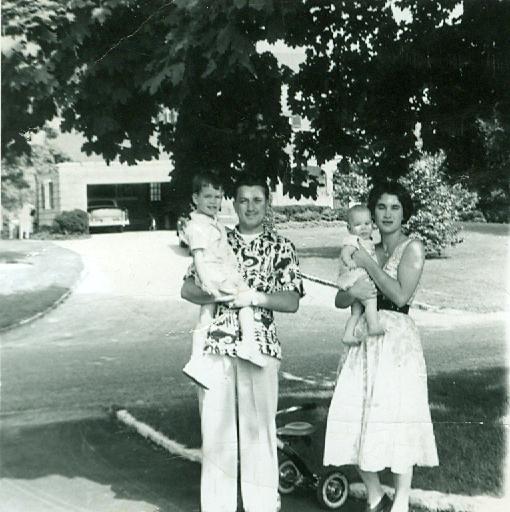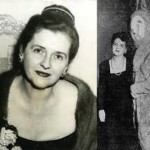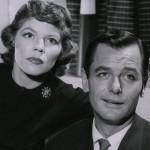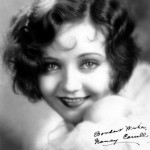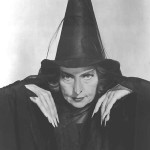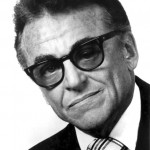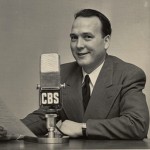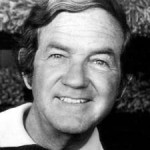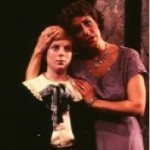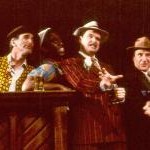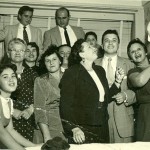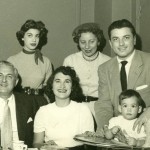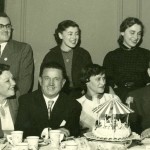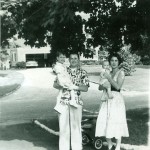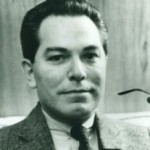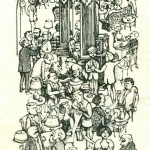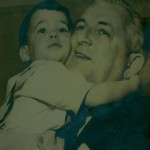
Michael, Grandpa Ben
Part 3: Screaming At Agnes Moorehead and Other Adventures
by Michael Elihu Colby
Born “Michael Elihu Colby,” I even had a middle name similar to Eloise of the Plaza. But I didn’t really live at the Algonquin—until I was 18. Nonetheless, I spent countless hours there throughout my childhood. And it’s uncanny how much happening there, even during my infancy, would affect my future.
In the year I was born, 1951, the hotel was the hangout for stars of the Broadway hit Don Juan In Hell (a “heavenly” situation for my grandparents, even if they didn’t understand the show). Consisting of the third act of Shaw’s Man and Superman, this production top-lined Algonquin regulars Charles Boyer (as Don Juan), Charles Laughton, Cedric Hardwicke, and Agnes Moorehead, with whom I’d have a memorable encounter some years later.
1952 produced the Broadway success Mrs. McThing, featuring such Algonquin regulars as Helen Hayes, Iggie Wolfington, and resident Enid Markey. Above all, it was written by Mary Chase (Pulitzer Prize winner for Harvey). Mary not only stayed at the Algonquin but would become my good friend; indeed—as an adult—I collaborated with Mary and composer Jack Urbont on the musical version of Mrs. McThing.
During my childhood, Mary would give me white chocolate bunnies—resembling her character Harvey—around Easter time. She had many merry times with my Grandma Mary, who recommended Mrs. McThing to everyone. Grandma made the show an especially magical experience for her niece Elinor Weisman. Elinor, who lived in a modest family apartment in Brooklyn, felt like Cinderella as she rode, beautifully attired, in the Bodne Rolls Royce to see Mrs. McThing alongside Grandma—who knew everyone at the show. Elinor (now Elinor Goodman) still beams discussing that night. Grandma Mary shared many such treasured nights with family members.
The Bodnes made a custom of attending Broadway opening nights, even if, during a performance, Grandma sometimes fell asleep and Grandpa would say things like, “Mary, I realize I forgot something—I forgot to stay home.” Still, Grandma gained a reputation for loving every show she saw (even the ones she spent in dreamland).
The Bodnes made it their business to keep up with theatre. Among many reasons, the Algonquin was the voting center for the N.Y. Drama Critics Circle ever since the group’s inception in 1935. The group’s choices in 1952, the first year of my life, coincidentally figured in my later life. The 1952 “Best Play” was John Van Druten’s I Am a Camera—based on Christopher Isherwood’s Berlin Stories—sources of the 1966 musical Cabaret, my favorite show and the main reason I started writing musicals. The 1952 “Best Musical” was Pal Joey, by Richard Rodgers, John O’Hara, and lyricist Lorenz Hart, whose sister-in-law and biographer Dorothy Hart would one day become my mentor.
In 1953, my personal Algonquin adventures began. A Hollywood star staying there became very fond of the cute two-year old who frequently visited his grandparents. Starring on Broadway in Edward Chodorov’s Oh Men! Oh Women!, Gig Young used to dandle me on his knee in the lobby. Young would exemplify some of the ascendant Algonquin guests whose fortunes would later tragically reverse. Born Byron Barr, he changed his name to “Gig Young,” the character he played in the film The Gay Sisters. He would win the Oscar in 1969 for his superlative performance in They Shoot Horses, Don’t They? When his career foundered, he killed himself and his wife.
Witnessing the ups and downs of Algonquin celebrities was a sobering experience that gave me an invaluable perspective on the mutability of success in the Arts. If that weren’t enough, Grandma Mary frightened me with cautionary tales. For instance, she told me about another guest I knew as a child: former Paramount star, Nancy Carroll. The story was that Nancy Carroll was hoping to make a comeback in a Broadway show, ironically titled Never Too Late. She even had her face lifted to play a pregnant women in her late 40’s. Carroll was devastated when the role went instead to the 51-year old Maureen O’Sullivan. Grandma recounted how her friend Nancy was found dead, a while later, slumped over her TV set watching old movies. The upside, Grandma reminded me, was “At least she looked years younger.”
In 1954, a blessed event occurred that would mean a move from New York City to Hewlett, Long Island for the Colby family. Another “Algonquin Kid” was born, the first of my two brothers, Douglas Steven Colby. As a gift, the Bodnes bought a stately white colonial home for the Colbys to move into—at an address sounding a little bit ominous: 1340 Paine Road.
Relocated to Hewlett, I wasn’t able to journey to the Algonquin as often. But, being the hotel’s associate manager, my father was soon taking the hour-drive there every working day. And, as my new brother grew older, my parents made sure we all visited the hotel, spending time with welcoming grandparents. I continued growing up at the Algonquin and, due to severe car-sickness, on at least two occasions arrived throwing up at the Algonquin.
1956 was a milestone year for me. I saw my first Broadway show, a musical of course—L’il Abner. One visit to this stage incarnation of Dogpatch and it was instant puppy love. 1956 was also the year something loverly was blooming in the Algonquin’s Room 908, one floor below the Bodnes’ apartment. Lyricist/librettist Alan Jay Lerner was in residence with a borrowed piano, while he and his composer Frederick Lowe were creating a new musical eventually titled My Fair Lady (Lerner’s uncle was in fact a go-between in the sale of the Algonquin to my grandfather). Ultimately, the sounds of late-night creativity bothered Grandpa Ben. He was not always astute about new musicals, having walked out of a backer’s audition for Kiss Me Kate, in midsummer, grumbling it was too damn hot.
One late night Grandpa could no longer stand the ivories tinkling in room 908, disturbing his sleep. He phoned the hotel operator to ask Lerner and Loewe to quiet down, complaining “I wouldn’t mind if they were writing something good, but this is just noise.” It turned out Lerner and Loewe were creating the song “I Could Have Danced All Night.”
The same year, the Algonquin was a setting where Leonard Bernstein, Arthur Laurents, and Jerome Robbins met to discuss the new musical they were developing which became West Side Story. At one point, they were thrown out of the hotel because “Laurents was not wearing a tie.” 1 Too bad maître d’ Raul couldn’t wrap a tablecloth around Laurents, as he had for Tallulah Bankhead.
Though their last names sounded alike, Laurents was not to be confused with fellow playwright Jerome Lawrence, who lived at the Algonquin when in New York. With his writing partner Robert E. Lee, Jerome Lawrence had authored the Broadway classic Inherit the Wind. During this period, they were working on a stage version of Patrick Dennis’ 1955 book, Auntie Mame: An Irreverent Escapade, a book loaded with references to the Algonquin. In the book, which begins in 1928, Auntie Mame is a friend of Algonquin owner Frank Case and devises “a personal shopping service as a convenience to guests” there. She also takes her secretary Agnes Gooch on an emancipating drinking binge at the hotel. In another scene, Mame decorates the Algonquin suite of her best friend, flamboyant actress Vera Charles.2 Jerome Lawrence and Robert E. Lee included none of these incidents in the play Auntie Mame (1957). But when they again adopted the story in the 1966 musical version (Mame), Mame’s first scene features this exchange with Frank Case: “Goodnight Frank. See you Tuesday at the Algonquin” 3 (A great plug for the hotel). It’s no wonder my Grandparents were very fond of the musical and Jerome Lawrence.
Meanwhile, 1956 was a banner personal year for the Bodnes family. My aunt Barbara Ann (whom I’ve always called “Aunt Bobbie”) would be marrying Andrew A. Anspach. Anspach, a graduate of Yale and Columbia Law School, had found great success as Director of Personnel and Labor Relations for Louis Sherry and Child’s (the ice cream and restaurant chain)—which merged with the Hotel Corporation of America. Grandpa Ben was very impressed with Andrew during the romance with Barbara, telling his daughter the Algonquin could use a man like that. Barbara replied, “I’ll see what I can do.” In no time, they were engaged. Barbara, whose pretty, patrician features were sometimes mistaken for actress Teresa Wright, was an elegant, cultured match for Andrew. Andrew was also a good match for the Algonquin. In 1957, he would succeed the retiring John Martin as the Algonquin’s Managing Director. Martin, who had worked at the hotel since Frank Case owned it, was the holdover who most helped Grandpa Ben stabilize the hotel during transition years. John Martin would not be an easy act to follow. But Uncle Andrew was ideal. In decades ahead, Uncle Andrew would further upgrade the hotel’s technology, enlarge its status as an international cultural mecca, and spearhead the esteemed re-opening of the Algonquin cabaret.
The Anspach wedding ceremony, the first I’d ever attended, took place in the living room of the Bodne apartment with a small reception downstairs. Ever fastidious, Grandma Mary worked like the dickens to make sure the apartment looked perfect for the occasion. Sometimes perfection has a price. As the appointed hour grew near, Grandma noticed one flaw. The venetian blinds looked dusty high atop one window. “Mary!” Grandpa shouted, “No one will notice—just leave it alone.” A few minutes later, there was a loud crash. Thanks to her cleaning fixation, Grandma had fallen off a chair. That’s why, in photos of the wedding, Grandma had a black eye.
On a historical level, the years 1956-1957 were the tail end of McCarthyism, aka the Red Scare. During this notorious period—which began around 1950—Senator Joseph McCarthy conducted hearings at the House of Un-American Activities Committee (HUAC) naming citizens as communists and subversives (often in an irresponsible, ruinous manner). People in the Arts were largely impacted. Hollywood, the TV industry, and other businesses had blackballed most anyone who was named by HUAC, but the Broadway community bypassed the hysteria. As NY theatre continued to employ talents who’d been blackballed elsewhere, my Grandparents made sure blacklist victims were welcome at the Algonquin. Arthur Miller would visit while writing The Crucible, his famous 1953 allegory on such witch-hunting. The hotel was neutral ground for such “named” artists as Dalton Trumbo, Ring Lardner Jr., Jules Dassin, Lillian Hellman, Ruth Gordon, and Zero Mostel. The closest the hotel came to embracing any McCarthy were actor Kevin and his sister, writer Mary McCarthy. Most notably my grandfather made the Algonquin the free-of-charge home for blacklisted radio host John Henry Faulk after CBS radio fired him in 1957. Represented by attorney Louis Nizer, Faulk’s dragged-out trial finally concluded with the largest libel settlement until that point: $3.5 million. The case became famous via Faulk’s book Fear on Trial, later presented as an Emmy-winning TV movie, ironically, on CBS. John Henry Faulk remained a dear friend to my family for the rest of his life.
Another example of my grandparents’ social conscience is how they made the Algonquin a haven for African Americans from early on. Through the years, their guest list boasted Maya Angelou, Roy Wilkins (head of the N.A.A.C.P.), and jazz greats like Ella Fitzgerald and Oscar Peterson. Perhaps their affinity was due to experiences in Charleston, South Carolina, where Great Grandpa Elihu Mazo was so close to the black community. A slight paradox was that my grandmother followed the Southern tradition of hiring black women to keep house and help raise children—in an affectionate if somewhat subordinating fashion. Grandma imported two such women from South Carolina, Louise Brown and Maggie Washington, who’d been employed in Charleston and who continued in the New York household of the Bodnes, as well as (later on) the Colbys. But, then again, my grandparents were full of contradictions, this countrified oilman—raised in Tennessee—and his Charleston wife now mingling with celebrities in very urbane surroundings.
As a kid, I knew I was especially lucky visiting the Algonquin when my grandparents introduced me to an array of illustrious guests—even if I didn’t always know who they were. Not everyone in Hewlett got to shake hands with Fred McMurray and his wife June Haver, Norman Granz (the jazz impresario/producer), Julie Andrews, Lotte Lenya, Leon Uris, Peter Ustinov, Burgess Meredith, and both Groucho and Harpo Marx. Harpo was particularly conspicuous. Honking first, he gave out souvenir taxi horns when he was promoting his book Harp Speaks! Moreover, he had a unique travel habit. According to 50-year employee Harry Celentano, “I checked Harpo in [as bellman]. He had his harp in a big crate, and we had a tough time getting it into the elevator.” 4
In 1958, I too made something of a spectacle of myself in the lobby. I had recently seen the TV episode “Rapunzel” on Shirley Temple’s Storybook, starring Carol Lynley in the title role. Suddenly, the other star of the episode entered the lobby and I was flabbergasted. “There’s the witch! There’s the awful witch!” I screamed for all to hear. Agnes Moorehead was none too pleased. Rather than introducing me, my grandmother hauled me away before further damage was done. I can just imagine what Moorehead’s character, Endora, might have done to me, years later, on her TV series Bewitched. Thank goodness Grandma Mary was there to protect me, at least in the lobby that day.
Next part: Dreams of Camelot
1 West Side Story—The Broadway Classic website: BB Promotion GmBH in cooperation with Sundance Productions, Inc.: http://www.westsidestory.de/index.php/en/show/historie
2 Dennis, Patrick. Auntie Mame: An Irreverent Escapade. New York: Vanguard Press, 1955.
3 Lawrence, Jerome, Lee, Robert E., Herman, Jerry. Mame. New York: Random House, 1967.
4 Anderson, Susan Heller. “City Makes It Official: Algonquin Is Landmark” in The New York Times, New York. September 30, 1987.
*No copyright Infringement Intended. For Entertainment Purposes Only.


